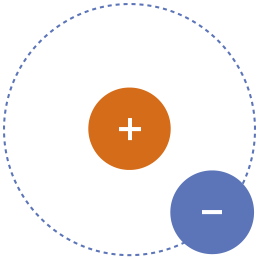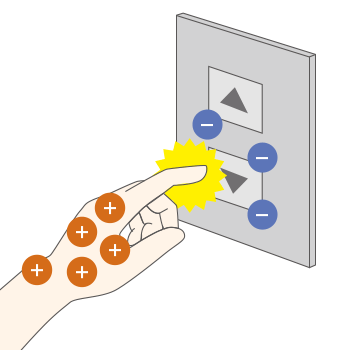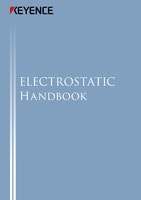What Is Static Electricity?
Static electricity is all around us in our lives. You may feel pain from a static shock triggered when you take off your clothes or touch an elevator button. Everyone has had that kind of experience one time or another.
What is static electricity, which makes most people, regardless of age or gender, uncomfortable? How is static electricity generated?
This section explains how static electricity is generated and the pain caused by static shocks.
How static electricity is generated
There are many things all around us. They are made of metal, plastic, and fibre―the materials and structures are infinite.
All these things around us have electric charge. Every object has both positive and negative charges. The same can be said for humans. Normally, the positive and negative charges an object has are equal.

The picture above shows a balanced state of charges, where the numbers of positive and negative charges are the same. In technical terms, this is called an “electrically neutral” state.
As the name implies, this is a state that is neither positively nor negatively charged. In other words, this is a state with no charge. Touching an electrically neutral object does not cause any static shock as there is no electric charge.
However, this balanced state is not constantly maintained and can easily be disturbed when certain events occur. Those events are collisions. When two different things collide with each other, negative charges can move from one object to the other.
In a collision, one side takes the negative charges released by the other side. This relationship occurs due to the difference in the force to pull negative charges between two objects. When two things collide, negative electric charge moves to the side with the stronger negative charge attracting force.

to the side with the stronger negative charge attracting force
The object that lost negative charges becomes electrically positive. The object that received negative charges becomes electrically negative. The originally balanced state is lost during the collision.
Static electricity is this imbalance of electric charge. Having static electricity is called being “charged” in technical terms.
Static electricity can be positive or negative.
Anything with static electricity is electrically imbalanced. Objects that are electrically imbalanced try to return to their original balanced state. For example, this is similar to when you trip on something and lose balance, you try to regain your footing. You don’t want to fall, so you try to plant your feet solidly to the ground for better balance.
What causes the pain from static shocks
What happens when a positively charged object comes close to a negatively charged object?
The negative charge on the negatively charged object tries to go to the positively charged object. This is to regain electrical balance. When these object touch or come very close together, the negative charge moves to the positively charged side.
This movement of negative charge is called an “electrostatic discharge.” Electrostatic discharge is a release of negative charge. When this occurs, electrical current flows between the objects.
Let’s take the example of an elevator button mentioned at the beginning of this section. Let’s suppose that the button on the elevator is negatively charged. On the other hand, you are positively charged (human bodies are prone to being positively charged).
When you touch a button on the elevator, negative charge flows into your hand. An electrostatic discharge occurs, and current is flowing into you. You receive an electric shock, which causes pain.
Generally speaking, this mild electric shock is referred to as “static electricity.” However, to be more precise, this is actually an electrostatic discharge caused by static electricity.







